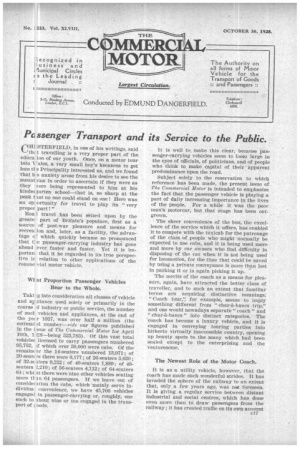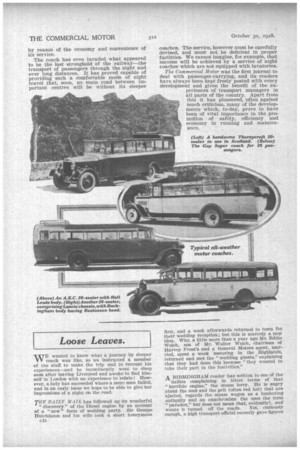Pc ssenger Transport and its Service to the Public.
Page 1

Page 2

If you've noticed an error in this article please click here to report it so we can fix it.
OHlISTERFIELD, In one of his writings, said th; t travelling is a very proper part of the educa ion of our youth. Once, on a motor tour into N 'ales, a very .small boy's keenness to get into ti e Principality interested us, and we found that Ii s anxiety arose from his desire to see the mount tins in order to ascertain if they were as they vere being represented to him at his kindet garten school—that is, so sharp at the peak t tat no one could stand on one Here was an op .ortunity for travel to play its "very proper part ! "
Roa I travel has been sized upon by the greate part of Britain's populace, first as a source of post-war pleasure and means for recrea ion and, later, as a facility, the advantage o ' which quickly became so pronounced that t e passenger-carrying industry has gone ahead ever faster and faster. Yet it is importan that it be regarded in its true perspective ir relation to other applications of the comme .cial motor vehicle.
WI at Proportion Passenger Vehicles Bear to the Whole.
Taki g into consideration all classes of vehicle and ap tlianCe used solely or primarily in the course if industry or public service, the number of and vehicles and appliances, at the end of the yel r 1927, was over half a million (the estimat cl number—vide • our figures. published In the I sue of The Commercial Motor for April 10th, 1 028—being 523,783). Of this vast total vehicleE licensed to carry passengers numbered 95,752, d which over 50,000 were cabs. Of the remain( er the 14-seaters numbered 13,971; of 20-seat( rs there were 6,177; of 26-seaters 5,020; of 32-sc iters 9,232; of .40-seaters 1,889; of 48seaters ?,,210; of 56-seaters 4,112; of 64-seaters 64; whi st there were nine other vehicles seating more ti an 64 passengers. If we leave out of considei ation the cabs, which mainly serve individua.: convenience, we have 45,700 vehicles engaged in passenger-carrying or, roughly, one such to about nine or ten engaged in the transport of oods. It is well to make this clear, because passenger-carrying vehicles seem to loom large in the eyes of officials, of politicians, and of people who think to make capital of their apparent predominance 'upon the road.
Subject solely to the reservation to whia reference has been made, the present issue of The Commercial Motor is intended to emphasize the fact that the passenger vehicle is playing a part of daily increasing importance in the lives of the people. For a while it was the poor man's motorcar, but that stage has been outgrown.
The sheer convenience of the bus, the excellence of the service which it offers, has enabled it to compete with the taxicab for the patronage of the class of people who might normally be expected to use cabs, and it is being used more and more by ear owners who find difficulty in disposing of the car when it is not being used for locomotion, for the time that could be saved by using a private conveyance is more than lost in parking it or in again picking it up.
The merits of the coach as a means for pleasure, again, have attracted the better class of traveller, and to such an extent that familiar terms are acquiring distinctive meanings. " Coach tour,". for example, seems to imply something different from " char-a-bancs trip," and one would nowadays separate " coach" and " char-h-bancs " into distinct categories. The 'coach has become a luxury vehicle, and it is engaged in conveying touring parties into hitherto virtually inaccessible country, opening up beauty spots to the many which had been sealed except to the enterprising and the venturesome. '
The Newest Role of the Motor Coach.
It is as a utility vehicle, however, that the coach has made such wonderful strides. It has invaded the sphere of the railway to an extent that, only a few years ago, was nait foreseen. It is giving a regular service between distant Industrial and social centres, which has done even more than to draw passengers from the railway ; it has created traffic on its own account
by reason of the economy and convenience of its service.
The coach has even invaded what appeared to be the last stronghold of the railway—the transport of passengers through the night and over long distances. It has proved capable of providing such a comfortable mode of night travel that, soon, no main road between important centres will be without its sleeper coaches. The service, however must be carefully devised, and must not be deficient in proper facilities. We cannot imagine, for .example, that
success will be achieved by a service of night
coaches which are not equipped with lavatories.
The Commercial Motor was the first journal to
deal with passenger-carrying, and its readers have always been kept freely posted with every development and given the benefit of the experiences of transport managers in all parts of the country. Apart from this it has pioneered, often against much criticism, many of the developments which, to-day, prove to have been of vital importance in the promotion of safety, efficiency and economy in running and maintenance.


















































